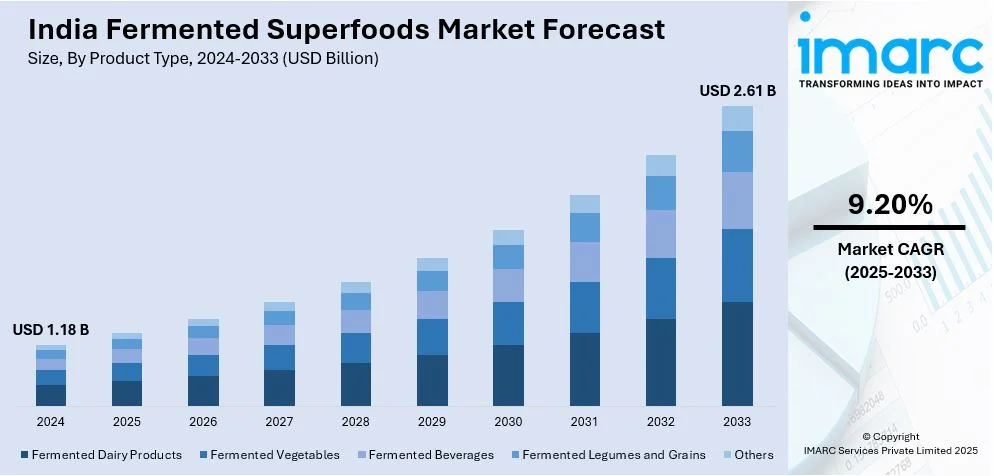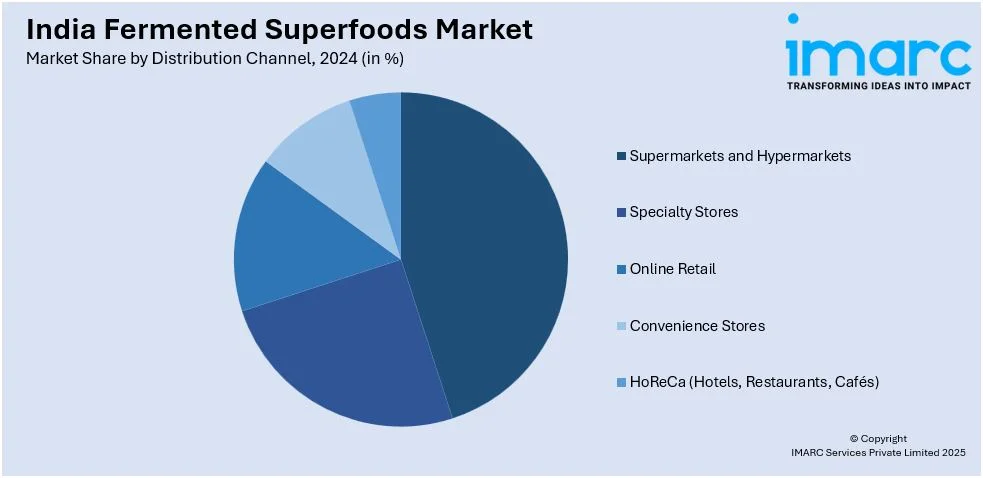
India Fermented Superfoods Market Size, Share, Trends and Forecast by Product Type, Distribution Channel, End User, and Region, 2025-2033
India Fermented Superfoods Market Overview:
The India fermented superfoods market size reached USD 1.18 Billion in 2024. Looking forward, IMARC Group expects the market to reach USD 2.61 Billion by 2033, exhibiting a growth rate (CAGR) of 9.20% during 2025-2033. The market is fueled by rising health awareness, demand for probiotics, and traditional dietary habits. Moreover, the growing interest in gut health, immunity boosting, and natural nutrition fuels consumption of fermented foods like yogurt, kimchi, kefir, and kombucha, are some of the other factors that further increase the India fermented superfoods market share.
|
Report Attribute
|
Key Statistics
|
|---|---|
|
Base Year
|
2024 |
|
Forecast Years
|
2025-2033
|
|
Historical Years
|
2019-2024
|
| Market Size in 2024 | USD 1.18 Billion |
| Market Forecast in 2033 | USD 2.61 Billion |
| Market Growth Rate 2025-2033 | 9.20% |
India Fermented Superfoods Market Trends:
Rising Health Awareness and Demand for Probiotics
Indian consumers are becoming increasingly health-conscious, leading to a higher demand for probiotic-rich foods that promote gut health, digestion, and immunity. Fermented superfoods such as yogurt, kefir, kombucha, and kimchi are becoming increasingly popular because of their natural probiotics and nutritional value. As lifestyle diseases like obesity and digestive disorders become a growing concern, individuals are actively looking for functional foods that promote overall well-being. The influence of nutritionists, fitness influencers, and healthcare professionals advocating the benefits of fermented foods has further accelerated their adoption in daily diets, which is driving the India fermented superfoods market growth. For instance, in October 2024, the Institute of Advanced Study in Science and Technology (IASST) announced its partnership with Bharat Biotech to develop probiotic health products from Northeast India, targeting lifestyle diseases like diabetes and obesity. This collaboration aims to commercialize innovative probiotic technologies, leveraging the region's biodiversity to enhance global health solutions. As more people seek natural and preventive health solutions, fermented superfoods rich in probiotics are gaining popularity.

To get more information on this market, Request Sample
Growing Urbanization and Changing Lifestyles
New patterns in urban growth, together with fast-paced modern lifestyles, have created a demand for ready-to-eat nutritious food options that are also convenient. The current food market shift towards ready meals seems perfect for fermented superfood options because they present quick, nutritious, and natural eating alternatives. As more Indians move to urban centers, exposure to global food trends has increased, boosting the demand for international fermented foods like sauerkraut, tempeh, and kombucha, which is creating the India fermented superfoods market outlook. For instance, in March 2025, Panitenga, a traditional fermented meal from Assam, was examined by researchers from the Indian Institute of Technology Guwahati to find advantageous bacterial strains with possible industrial uses. An essential part of Assamese cooking, panitenga is created by fermenting mustard seeds with acidic extracts from lime juice, tamarind, or mangosteen. The mixture is then kneaded into a dough, wrapped in banana leaves, and allowed to ferment for one to two weeks in bamboo vessels. In addition to improving the flavor and texture, this age-old preparation technique encourages the development of healthy microorganisms. As urban consumers seek nutritious, ready-to-eat, and natural foods, traditional fermented foods like Panitenga offer convenience and health benefits.
India Fermented Superfoods Market Segmentation:
IMARC Group provides an analysis of the key trends in each segment of the market, along with forecasts at the regional level for 2025-2033. Our report has categorized the market based on product type, distribution channel, and end user.
Product Type Insights:
- Fermented Dairy Products
- Yogurt
- Kefir
- Buttermilk
- Fermented Vegetables
- Kimchi
- Sauerkraut
- Pickles
- Fermented Beverages
- Kombucha
- Kanji
- Fermented Teas
- Fermented Legumes and Grains
- Idli
- Dosa
- Dhokla
- Tempeh
- Miso
- Others
The report has provided a detailed breakup and analysis of the market based on the product type. This includes fermented dairy products (yogurt, kefir, and buttermilk), fermented vegetables (kimchi, sauerkraut, and pickles), fermented beverages (kombucha, kanji, and fermented teas), fermented legumes and grains (idli, dosa, dhokla, tempeh, and miso), and others.
Distribution Channel Insights:

- Supermarkets and Hypermarkets
- Specialty Stores
- Online Retail
- Convenience Stores
- HoReCa (Hotels, Restaurants, Cafés)
A detailed breakup and analysis of the market based on the distribution channel have also been provided in the report. This includes supermarkets and hypermarkets, specialty stores, online retail, convenience stores, and HoReCa (hotels, restaurants, cafés).
End User Insights:
- Households
- Food Service Industry
- Health and Wellness Industry
A detailed breakup and analysis of the market based on the end user have also been provided in the report. This includes households, the food service industry, and the health and wellness industry.
Regional Insights:
- North India
- South India
- East India
- West India
The report has also provided a comprehensive analysis of all the major regional markets, which include North India, South India, East India, and West India.
Competitive Landscape:
The market research report has also provided a comprehensive analysis of the competitive landscape. Competitive analysis such as market structure, key player positioning, top winning strategies, competitive dashboard, and company evaluation quadrant has been covered in the report. Also, detailed profiles of all major companies have been provided.
India Fermented Superfoods Market News:
- In August 2023, Daily Need Exim Pvt Ltd introduced Natto, a traditional Japanese superfood, to the Indian market through its online shop, MAIN DISH.in. Known for its health benefits, Natto is rich in protein, vitamin K2, and promotes digestion. The company now has five branches, including a new outlet in Kolkata.
- In September 2023, Tempeh Today and Marel India announced their partnership to establish 20 small-scale tempeh fermentation units across India, aiming to enhance local protein production. This initiative, led by Schouten Foods, emphasizes sustainability and food security by sourcing ingredients from local farmers and providing training and support for operators in the fermentation units.
India Fermented Superfoods Market Report Coverage:
| Report Features | Details |
|---|---|
| Base Year of the Analysis | 2024 |
| Historical Period | 2019-2024 |
| Forecast Period | 2025-2033 |
| Units | Billion USD |
| Scope of the Report |
Exploration of Historical Trends and Market Outlook, Industry Catalysts and Challenges, Segment-Wise Historical and Future Market Assessment:
|
| Product Types Covered |
|
| Distribution Channels Covered | Supermarkets and Hypermarkets, Specialty Stores, Online Retail, Convenience Stores, HoReCa (Hotels, Restaurants, Cafés) |
| End Users Covered | Households, Food Service Industry, Health and Wellness Industry |
| Regions Covered | North India, South India, East India, West India |
| Customization Scope | 10% Free Customization |
| Post-Sale Analyst Support | 10-12 Weeks |
| Delivery Format | PDF and Excel through Email (We can also provide the editable version of the report in PPT/Word format on special request) |
Key Benefits for Stakeholders:
- IMARC’s industry report offers a comprehensive quantitative analysis of various market segments, historical and current market trends, market forecasts, and dynamics of the India fermented superfoods market from 2019-2033.
- The research report provides the latest information on the market drivers, challenges, and opportunities in the India fermented superfoods market.
- Porter's five forces analysis assist stakeholders in assessing the impact of new entrants, competitive rivalry, supplier power, buyer power, and the threat of substitution. It helps stakeholders to analyze the level of competition within the India fermented superfoods industry and its attractiveness.
- Competitive landscape allows stakeholders to understand their competitive environment and provides an insight into the current positions of key players in the market.
Key Questions Answered in This Report
The fermented superfoods market in India was valued at USD 1.18 Billion in 2024.
The India fermented superfoods market is projected to exhibit a (CAGR) of 9.20% during 2025-2033, reaching a value of USD 2.61 Billion by 2033.
The market is propelled by increasing health awareness, awareness of gut health, and demand for dense nutrition foods. Urbanization, the uptake of functional foods, and cultural inclination towards fermented foods all fuel consumption, as aided by innovation in flavors, packaging, and availability through modern retail and online channels.
Need more help?
- Speak to our experienced analysts for insights on the current market scenarios.
- Include additional segments and countries to customize the report as per your requirement.
- Gain an unparalleled competitive advantage in your domain by understanding how to utilize the report and positively impacting your operations and revenue.
- For further assistance, please connect with our analysts.
 Request Customization
Request Customization
 Speak to an Analyst
Speak to an Analyst
 Request Brochure
Request Brochure
 Inquire Before Buying
Inquire Before Buying




.webp)




.webp)












